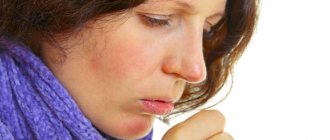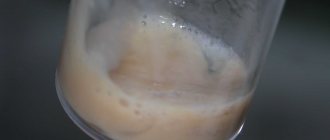18.12.2020 Sputum
- mucus produced by the trachea and bronchi, mixed with secretions from the nasal mucosa and saliva. What is it for? With it, dust and microbes are removed from the body, which inevitably get inside with our breath. This substance in itself is not a sign of disease: a healthy body generates approximately 100 ml of clear sputum every day - it is quietly swallowed and dissolved by gastric juice.
Another thing is a pathological process in which up to 1.5 liters of viscous mucus per day can be produced. In this case, it is coughed up and may look completely different. The color of sputum when coughing indicates the specifics of the disease and its severity.
general characteristics
In the lumen of the tracheobronchial tree of a healthy person, up to 100 ml of transparent mucus collects during the day, which has bactericidal properties, participates in metabolism, elimination of infectious agents and small foreign particles from the respiratory tract.
The formation of secretion does not cause coughing or discomfort and goes unnoticed. Sputum is produced in excess quantities in diseases of the nose, its paranasal sinuses, respiratory and digestive organs. The volume of discharge varies depending on the pathological process, in some diseases it reaches 4,000 ml per day.
Sputum may come out easily or be difficult to cough up. Mucus often contains blood impurities and foreign inclusions (dust, metal particles, microliths). In most cases, bronchial secretions are odorless; the color is influenced by the nature of the underlying disease.
How to learn to cough correctly
Many respiratory diseases are transmitted through airborne droplets. To prevent infection of others, you need to:
- tilt your head down;
- cover your mouth with the inside of your elbow;
- tighten your abdominal muscles;
- make a forced exhalation.
During a cough, the speed of air expulsion reaches 170 km/h. Along with it, many pathogens enter the environment. Therefore, when coughing, cover your mouth. During an exacerbation of the disease, it is recommended to wear a mask, which is changed at least once every half hour.
It is recommended to cough up mucus into a disposable paper tissue. After an attack, wash your hands with antibacterial soap.
To avoid complications, stay in bed for the first 3-5 days.
ENT doctors do not advise holding back a cough, as it helps clear the airways of phlegm and pathogens.
A cough with hard-to-clear sputum is a sign of respiratory diseases caused by inflammation of the lower respiratory tract. To alleviate the condition, you need to take mucolytics, follow a drinking regime and do inhalations.
Classification
The consistency of sputum can be thick, viscous or thin and watery. When settling, in some cases it is divided into 2 or 3 layers. Based on physical properties (color, smell, transparency, other macroscopic characteristics), the following types of sputum are distinguished:
- Serous.
Isolated in acute left ventricular failure accompanied by pulmonary edema. Characterized by the absence of odor, watery consistency, and an abundance of foam. Serous sputum is usually colorless, sometimes has a pinkish tint. - Mucous.
The appearance of mucous discharge indicates the onset of inflammation of the respiratory tract or the attenuation of the activity of an acute pathological process. Sputum is coughed up in small quantities and is colorless, viscous mucus. - Mucopurulent.
Formed in the acute period of many respiratory diseases. This type of secretion is characterized by increased viscosity and the presence of yellow or green impurities. - Purulent.
Appears with severe inflammation, suppurative processes of the respiratory system. The consistency of the purulent secretion is liquid, the color is green or yellow-green, and sometimes there is a putrid odor.
Perhaps there are shocking photos of medical operations hidden here that show blood and guts.
Are you over 18 years old?
Yes
No
Purulent sputum
Diet for bronchial asthma
Following a diet significantly speeds up the healing process. Among other things, this allows you to avoid food allergens.
People with asthma should not eat:
- smoked meats;
- fatty meats;
- citrus;
- seafood;
- strawberries;
- eggs;
- nuts;
- chocolate;
- apricot;
- peach;
- tomatoes.
Can be eaten:
- chicken;
- doctor's sausage;
- oat cookies;
- Rye bread;
- fruit and vegetable salads;
- coffee;
- tea;
- cereal porridge with butter;
- uncooked soups.
You should limit the consumption of foods such as sugar, milk, salt, sour cream and baked goods. It is also worth following a diet: eat small portions, but 4-5 times during the day[5].
Bibliography:
[1] Ovcharenko S.I. Bronchial asthma: diagnosis and treatment / S.I. Ovcharenko // RMJ, 2002. – No. 17 (10). – 766 p.
[2] Fedoseev B. G. Possibilities of preclinical diagnostics and mathematical prediction of the risk of bronchial asthma (dissertation) / B. G. Fedoseev. - M.: State Educational Institution VP "St. Petersburg State Pediatric Medical Academy", 2005. - No. 2. - P. 35-40.
[3] Tereshchenko S. Yu. Efficacy of various modes of maintenance anti-inflammatory therapy for mild/moderate bronchial asthma in children / S. Yu. Tereshchenko // Allergology. - 2006. - No. 2. - 13-23 p.
[4] Gushchin I.S. Cetirizine is a standard H1 antihistamine [electronic resource]. – Access mode: www.health–medix.com. – (Date of last access: 10/16/17).
[5] Diet No. 9 [Electronic resource]. – Access mode: https://www.medicina.ru. – (Last access date: 10/1/17).
[6] Instructions for use of the medicinal product for medical use Cetrin®. – Registration number: P N013283/01
Causes of sputum formation
Causes of purulent sputum
The appearance of purulent yellow or yellow-green discharge indicates the presence of a severe acute respiratory infection or an exacerbation of a chronic inflammatory disease of the respiratory tract. Purulent, foul-smelling sputum released with coughing accompanies various destructive processes of the lungs and is observed when pathological contents stagnate in bronchiectasis. The most common causes of purulent secretion are:
- Bronchitis:
acute purulent bronchitis, chronic purulent process in the acute phase. - Bronchiectasis:
bronchitis or mixed variant of COPD, bronchiectasis. - Pulmonary destruction:
lung gangrene, lung abscess. - Neoplasms:
decaying lung cancer.
Causes of thick/sticky sputum
Coughing up viscous mucus or mucopurulent secretion occurs in most diseases of the bronchopulmonary system. Any acute respiratory pathology manifests itself as an unproductive cough with thick, light or yellowish sputum. Chronic diseases are accompanied by the release of viscous secretions during remission. The most common coughing up of thick mucus is observed in the following pathologies:
- Acute respiratory infections:
tracheitis, bronchitis, pneumonia. - Hereditary diseases:
cystic fibrosis, Kartagener syndrome. - Pulmonary mycoses:
candidiasis, aspergillosis, zygomycosis. - Chronic lung diseases:
COPD, bronchial asthma, chronic bronchitis.
Causes of mucous sputum
Some diseases of the respiratory system are manifested by the discharge of thin, watery mucus. Sometimes such sputum is released in single spits, but in a number of diseases there can be a lot of it. Coughing with mucus is often observed in acute airway infections. Mucous sputum, the causes of which are associated with chronic pathology, is coughed up during remission. Excessive production of clear mucus occurs due to the following conditions:
- Manifestation of acute respiratory diseases:
bronchitis, pneumonia. - Remission of chronic respiratory pathology:
COPD, chronic bronchitis. - Attack period of bronchial asthma.
- Infiltrative pulmonary tuberculosis.
- Neoplastic process:
non-small cell cancer, pulmonary adenomatosis. - Digestive diseases:
GERD.
Causes of yellow sputum
Often the sputum secreted by the patient turns yellow due to the activation of bacterial microflora. The appearance of such mucus in the morning may occur due to an admixture of nasal secretions that flow into the trachea during sleep. Sometimes sputum acquires a rich yellow tint due to food colorings and an increased content of eosinophils. The main diseases with the release of yellow sputum:
- Diseases of the nose and paranasal sinuses:
rhinitis, sinusitis. - Acute diseases of the respiratory system:
bronchitis, tracheitis, pneumonia. - Chronic respiratory diseases:
chronic bronchitis, bronchiectasis, COPD. - Eosinophilic infiltrates:
ascariasis, hookworm, drug allergies. - Specific infections:
pulmonary forms of syphilis, tuberculosis.
Causes of mucopurulent sputum
Expectoration of mucus with pus indicates an acute, advanced stage of bronchopulmonary disease. Sometimes mucopurulent sputum is rusty in color and may contain streaks or droplets of blood. Simultaneously with the appearance of pathological impurities, the volume of discharge increases. The main diseases in which there is coughing of mucopurulent contents:
- Acute diseases of the bronchi and lungs:
bronchitis, pneumonia. - Chronic pathology of the respiratory tract:
chronic bronchitis, COPD, the presence of bronchiectasis. - Specific diseases:
tuberculosis of the bronchi, lungs, pulmonary syphilis. - Rare hereditary pathology:
cystic fibrosis. - Malignant neoplasms:
bronchopulmonary carcinoma. - Mycoses of the lungs:
actinomycosis.
Causes of foul-smelling sputum
The strong unpleasant odor of sputum is due to stagnation of the contents of the cavity formations of the lungs, putrefactive processes associated with the activity of anaerobic microflora. When such a cavity is drained into the bronchus, a large amount of foul-smelling semi-liquid secretion is coughed up. Morning sputum sometimes has a strong smell due to impurities in nasopharyngeal secretions. The main pathologies accompanied by this symptom include:
- Suppurative pulmonary diseases:
lung abscess, lung gangrene, pleural empyema. - Neoplastic processes:
disintegration of a cancerous tumor. - Specific infections:
disintegration of syphilitic gumma, drainage of tuberculous cavity. - Bronchiectasis.
- Diseases of the nasopharynx:
ozena.
Causes of green sputum
Green sputum is the result of bacterial infection and stagnation of secretions in the respiratory tube, bronchiectasis, and cavity formations. This discharge usually has a purulent, mucopurulent character, and sometimes has an intense putrefactive odor. Coughing up green contents may indicate a serious bronchopulmonary disease, often observed with pathologies such as:
- Acute diseases of the respiratory system:
bronchitis, pneumonia. - Pulmonary purulent destruction:
gangrene, lung abscess. - Suppurative diseases of the pleura:
pyothorax. - Respiratory tuberculosis:
fibrous-cavernous pulmonary tuberculosis, pleural empyema with tuberculous pleurisy. - Bronchiectasis of any origin.
- Hereditary diseases:
cystic fibrosis.
Diagnostics
Diagnosis of diseases in which sputum is produced is carried out by pulmonologists or therapists. During the survey, the duration of the illness, the presence of occupational hazards, and the connection with smoking are clarified. The examination reveals signs of hypoxia and symptoms of distal hypertrophic osteoarthropathy. The following methods help to finally find out why the patient is coughing up sputum:
- Physical examination.
Local dullness of percussion sound allows one to suspect pneumonia and the presence of pleural effusion. Dry wheezing during auscultation indicates bronchial obstruction, moist and crepitating pathological respiratory sounds are heard during infiltration of the lung tissue. - Visualization methods.
X-ray of the lungs reveals infiltrates of the pulmonary parenchyma, spherical formations, and the presence of lung destruction. CT and MRI of the chest are prescribed to clarify the localization of the pathological process. Signs of pyothorax can be visualized using x-ray or ultrasound of the pleural cavity. - Endoscopic techniques.
Bronchoscopy makes it possible to examine the mucous membrane of the bronchi and trachea. Using this method, you can detect manifestations of bronchitis, bronchiectasis, and areas of bronchostenosis. Under the control of a bronchoscope, a biopsy of suspicious areas of the bronchial wall is performed. Fibrogastroscopy is performed to exclude GERD, rhinoscopy is performed if nasopharyngeal pathology is suspected. - Laboratory research.
Peripheral blood tests reflect inflammatory changes in the body. During a microscopic examination of sputum, its physical qualities are assessed, Kurshman spirals, Dietrich plugs, and other inclusions are identified. The cultural method allows you to detect the causative agent of an infectious disease and determine its sensitivity to antibiotics.
Sometimes, when coughing with sputum, spirometry, body plethysmography, and allergy diagnostics are additionally performed. To exclude syphilis, helminthic infestations, and pulmonary mycoses, serological tests are performed. To diagnose hereditary pathology, molecular genetic methods and special studies are used. To confirm tuberculosis, the Mantoux test, Diaskin and Quantiferon tests can be used.
Bronchoscopy is performed for both diagnostic and therapeutic purposes.
Shortness of breath in bronchial asthma
Frequent attacks of shortness of breath during exacerbation of the disease are characteristic. There is a violation of breathing frequency, as well as rhythm and depth.
The shortness of breath that accompanies patients with asthma manifests itself precisely when exhaling. The time to exhale increases due to the narrowing of the lumen.
Often an attack of shortness of breath “forces” the patient to take a sitting position. A person suffering from asthma raises his shoulders, rests his hands on his knees, and begins to take large gulps of air. This situation is commonly called orthopnea in medicine.
An attack of shortness of breath helps a person suffering from asthma to remove excess carbon dioxide from the body and saturate it with oxygen[1].
Treatment
Help before diagnosis
Long-lasting, regularly expectorated sputum is a reason for a mandatory visit to the doctor. If you are coughing up liquid purulent contents with your mouth full, there is hemoptysis or rust-colored sputum, a visit to a medical facility should be urgent. Before making a diagnosis, it is recommended to drink plenty of warm alkaline drinks, expectorant herbal teas and medications, and breathing exercises.
Conservative therapy
There are a large number of pathologies in which sputum is coughed up; treatment depends on the etiology and mechanism of development of the disease. Conservative measures include the use of pharmacological agents and physiotherapeutic procedures, physical therapy. Medicines can be divided into the following groups:
- Etiotropic.
Antibiotics are prescribed for bacterial infections, taking into account the sensitivity of the microflora. When treating tuberculosis, combinations of anti-tuberculosis drugs are used. Antifungal medications are indicated for fungal diseases, anthelmintic medications for helminthic infestations. - Pathogenetic.
Includes expectorants. During treatment, sputum becomes more liquid and is better removed from the bronchi. Preference is given to mucolytics and mucoregulators. The group of pathogenetic agents also includes bronchodilators and corticosteroid hormones used for bronchial obstruction. For malignant neoplasms, antitumor medications are recommended.
Physiotherapeutic treatment is actively used for a number of pulmonary diseases. Patients are prescribed medicinal inhalations and breathing exercises. Sputum is cleared well after percussion massage of the chest. Patients are trained in postural drainage techniques. If necessary, sanitary bronchoscopy is performed.
Analyzes and examinations
If you cough up clear, white, green or rusty sputum, consult a doctor. After collecting anamnestic data, he will draw up a diagnostic plan, based on the results of which he will determine the cause of ill health.
Analyzes and examinations:
- Spirography. White color of sputum during a cough that lasts more than 2 weeks is a reason to determine external respiration disorders. The doctor evaluates breathing rigidity, lung capacity and forced expiratory volume.
- Bronchoscopy. If the bronchi are affected, an endoscopic examination is performed, during which a tube with a camera is inserted into the trachea. This is how foci of inflammation, tumors and developmental defects of the tracheobronchial tree are determined.
- Chest X-ray. Based on the results, the condition of the lungs and bronchi and the presence of neoplasms are assessed.
- Sputum culture. During the analysis, the causative agent of the infection and the sensitivity of bacteria to antibiotics are determined.
To distinguish inflammatory diseases from autoimmune, oncological and allergic diseases, a general blood test and serological tests will be required.
Wet cough in children
Parents should be wary of a wet cough in children if it is accompanied by the following symptoms:
- The cough is sudden and persistent;
- Shortness of breath appears;
- Increased body temperature, for three days does not drop below 38 degrees;
- The child completely refuses to eat;
- Chest pain;
- Cough with wheezing, audible at a distance;
- Cough with blood elements;
- Cough with green sputum;
- Cough that developed against the background of ARVI, lasting more than 20 days;
- A persistent wet cough that lasts for weeks or months.
In such cases, effective treatment of the disease that caused the wet cough is necessary. An urgent call to a specialist doctor, even with minor signs of illness, is necessary for all children under 1 year of age, as well as for children with severe chronic illnesses.









